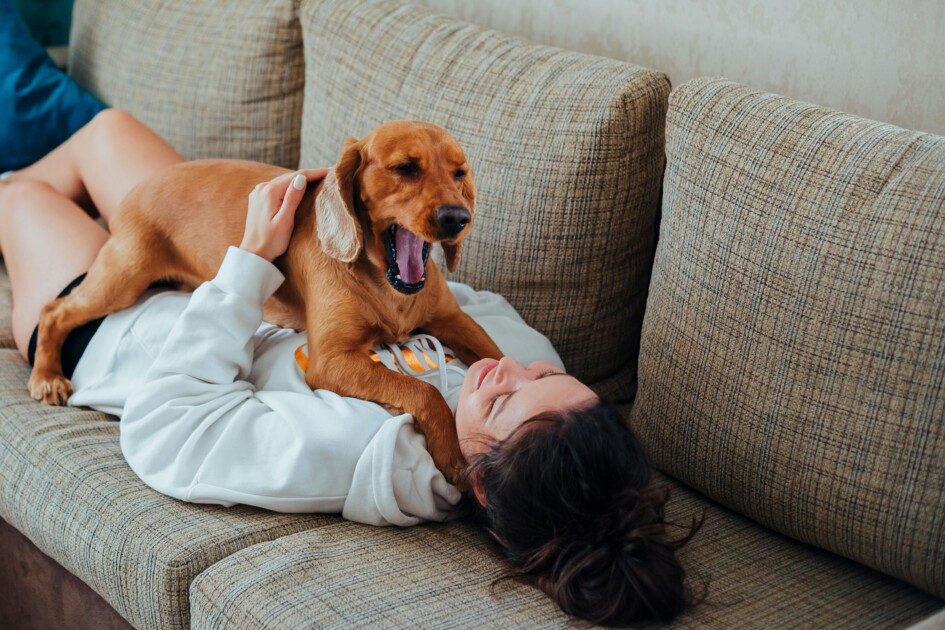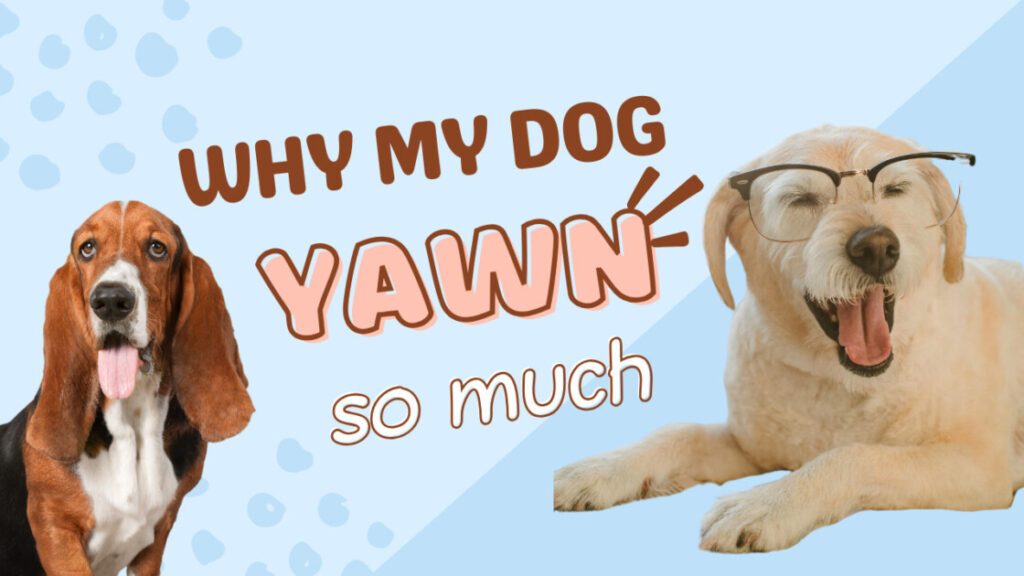As a fellow pet lover, I often find myself puzzled by my dog’s behaviors. One of the most curious habits I’ve noticed is how often my dog yawns. Sometimes, it seems like every time I look at him, he’s yawning. If you’re wondering, “Why does my dog yawn so much?” you’re not alone. In this article, I’ll delve into the reasons behind this common canine behavior and explore why your dog might yawn when you pet him, talk to him, or even just when he’s sitting around.

Understanding Canine Yawning
What is Yawning?
Yawning is a natural reflex in both humans and animals. It involves opening the mouth wide, inhaling deeply, and then exhaling. While yawning is often associated with tiredness or boredom in humans, dogs yawn for various reasons, many of which are different from our own.
Why Does My Dog Yawn So Much?
Dogs yawn frequently for several reasons, and understanding these can help us better care for our furry friends. Here are some common reasons why your dog might yawn a lot:
- Stress and Anxiety
- Just like us, dogs can feel stressed or anxious. Yawning is one way they cope with these feelings. If your dog yawns during a stressful situation, such as a vet visit or a car ride, it’s likely a sign of anxiety.
- Communication
- Dogs use body language to communicate, and yawning is a part of this. A yawn can signal that your dog is feeling uncomfortable or wants to avoid conflict. It’s a way for them to calm themselves and others around them.
- Empathy and Mimicry
- Have you ever noticed that your dog yawns when you yawn? This is known as contagious yawning and is a sign of empathy. Dogs are highly attuned to their human companions and often mimic our behaviors.
- Tiredness and Boredom
- Of course, dogs also yawn when they are tired or bored. If your dog has had a long day of play or hasn’t had much stimulation, yawning is a natural response.
Why Does My Dog Yawn When I Pet Him?

Comfort and Relaxation
One of the most heartwarming experiences as a dog owner is petting your dog and seeing them relax. You might notice that your dog yawns when you pet him, which can be a sign of comfort. When dogs feel safe and relaxed, they may yawn as a way to release tension and enjoy the moment.
Bonding and Affection
Yawning during petting can also be a sign of bonding. It’s a way for your dog to show that he feels comfortable and trusts you. This yawn is different from one caused by stress; it’s a signal of a happy and content dog.
Stress and Overstimulation
On the flip side, if your dog yawns excessively while you’re petting him, it could be a sign of overstimulation or stress. Pay attention to other body language cues, such as tense muscles or averted eyes, to determine if your dog is feeling overwhelmed.
Why Does My Dog Yawn When I Talk to Him?
Attention and Engagement
When you talk to your dog, he might yawn as a way to show that he’s paying attention. It’s a way for him to stay engaged in the interaction. This kind of yawning is usually accompanied by other signs of attentiveness, such as ears perked up or a wagging tail.
Confusion and Uncertainty
Sometimes, dogs yawn when they are confused or uncertain. If you’re giving commands or talking in a tone that’s unfamiliar to them, they might yawn as a way to process the information. It’s their way of saying, “I’m trying to understand.”
The Science Behind Canine Yawning
Yawning as a Calming Signal
Canine behaviorists have studied yawning extensively and found that it often serves as a calming signal. Dogs use yawning to diffuse tension in social situations, both with other dogs and humans. It’s a way for them to communicate that they mean no harm and want to keep things peaceful.
Contagious Yawning and Empathy
Research has shown that dogs, like humans, can experience contagious yawning. This behavior is linked to empathy and social bonding. When your dog yawns after you yawn, it’s a sign that he is closely attuned to your emotions and is mirroring your behavior.
How to Respond to Your Dog’s Yawning
Recognize the Context
The first step in responding to your dog’s yawning is to recognize the context. Is your dog yawning because he’s tired, stressed, or relaxed? Understanding the reason behind the yawn can help you respond appropriately.
Provide Comfort and Reassurance
If your dog is yawning due to stress or anxiety, provide comfort and reassurance. Speak to him in a calm, soothing voice and offer gentle petting. Creating a safe and comfortable environment can help reduce his stress.
Encourage Relaxation
For dogs that yawn out of tiredness or boredom, ensure they have plenty of opportunities to rest and relax. Provide a comfortable bed and a quiet space where they can unwind. Regular exercise and mental stimulation are also important to keep your dog happy and healthy.
Tips for Reducing Stress-Induced Yawning
- Create a Calm Environment
- Ensure your home is a calm and safe place for your dog. Avoid loud noises and sudden movements that can startle or stress him.
- Routine and Consistency
- Dogs thrive on routine and consistency. Keep a regular schedule for feeding, walking, and playtime to help your dog feel secure.
- Positive Reinforcement
- Use positive reinforcement techniques to reward calm behavior. Treats, praise, and affection can help reinforce that your dog is safe and loved.
- Socialization and Training
- Proper socialization and training can help reduce anxiety and stress. Expose your dog to different environments, people, and other animals in a controlled and positive manner.
Location, Location, Location: Where Your Dog Yawns Matters
The context of your dog’s yawn can provide valuable clues to its meaning. Here’s a closer look at some specific scenarios:
- Yawning During Petting: This could be a sign of mixed messages. While they enjoy the physical contact, they might be feeling a bit overwhelmed by the attention. Try shortening your petting sessions or focusing on calmer strokes instead of vigorous petting.
- Yawning During Training: As mentioned earlier, yawns can indicate stress or confusion. Reassess your training methods and ensure you’re using positive reinforcement techniques. Keep training sessions short and engaging to avoid overwhelming your pup.
- Yawning When You Talk to Them: This could be a case of social yawning, mirroring your behavior, or it might signify they’re disengaged with the conversation (yes, dogs can tune us out too!). Try using a more playful tone of voice or incorporate physical interaction into your conversations.
Understanding Your Dog’s Body Language: Yawns Are Just One Piece of the Puzzle
While yawns are a key communication tool, it’s important to consider your dog’s entire body language to fully understand their message. Here are some additional cues to watch for:
- Tail Position: A low, tucked tail can indicate fear or anxiety, while a high, wagging tail usually means happiness.
- Ear Position: Flattened ears can be a sign of stress or submission, while perked-up ears often signify alertness or interest.
- Facial Expressions: A furrowed brow or squinting eyes might indicate discomfort, while a relaxed face often signifies contentment.
Ruling Out Medical Causes: When to See Your Veterinarian
Although yawns are usually a normal part of a dog’s communication, excessive yawning could sometimes indicate an underlying medical condition. Here’s when you should consult your veterinarian:
- Sudden Increase in Yawning: If your dog’s yawning frequency suddenly increases, it’s best to schedule a vet visit to rule out any medical issues.
- Yawning Accompanied by Other Symptoms: If your dog’s yawning is accompanied by lethargy, loss of appetite, or other concerning signs, it’s important to seek professional medical advice.
Conclusion
Yawning is a natural and common behavior in dogs, and it can have various meanings depending on the context. Whether your dog is yawning due to stress, tiredness, or empathy, understanding the reasons behind it can help you better care for your furry friend. By recognizing the signs and responding appropriately, you can ensure your dog feels safe, comfortable, and loved.
If you ever have concerns about your dog’s yawning or overall behavior, don’t hesitate to consult with a veterinarian or a professional dog trainer. They can provide valuable insights and guidance tailored to your dog’s specific needs. Remember, a happy and healthy dog makes for a happy and loving home!
Yawning Yonder: Decoding Your Dog’s Sleepy Stretches – Why Does My Dog Yawn So Much? – FAQ
Ever wondered why your dog yawns so much? This FAQ dives into the various reasons behind canine yawns, helping you decipher your furry friend’s communication.
1. My dog yawns all the time, even when they seem happy. Why?
There are many reasons for dog yawns beyond just sleepiness. Yawns can be calming signals, a response to stress or anxiety, or even social interaction (contagious yawning!).
2. Why does my dog yawn when I pet them?
While they might enjoy the physical contact, a yawn during petting could indicate they’re feeling a bit overwhelmed by the attention. Try shorter petting sessions or calmer strokes.
3. My dog yawns during training. Does it mean they’re not paying attention?
Yawning during training can signal stress or confusion. Reassess your training methods, use positive reinforcement, and keep sessions short and engaging to avoid overwhelming your pup.
4. My dog yawns when I talk to them. Are they bored with me?
It could be social yawning (mirroring your behavior) or disinterest. Try using a playful tone or incorporating physical interaction into your conversations.
5. When should I be concerned about my dog’s yawning?
Sudden increases in yawning or yawning accompanied by other symptoms like lethargy or loss of appetite warrant a visit to the veterinarian to rule out any underlying medical issues.
6. How can I respond to my dog’s yawns?
Respect their boundaries when they yawn during petting. If they yawn during training, shorten sessions or adjust your approach. For boredom yawns, provide mental stimulation with interactive toys or games.
7. Are there other signs I should look for besides yawning?
Absolutely! Tail position, ear position, and facial expressions all play a role in understanding your dog’s communication. A low tail might indicate fear, while perked-up ears often signify alertness.
8. Where can I learn more about dog behavior?
Your veterinarian is a great resource. Consider consulting a certified professional dog trainer for personalized advice on understanding and responding to your dog’s communication.
9. What are some resources for finding a certified dog trainer?
The Association of Professional Dog Trainers (APDT) offers a search tool to locate trainers in your area: https://apdt.com/.
10. Is there anything else I can do to strengthen my bond with my dog?
Absolutely! Beyond responding to their yawns, focus on providing them with plenty of love, exercise, and mental stimulation. This builds trust and strengthens the special connection you share with your furry best friend.